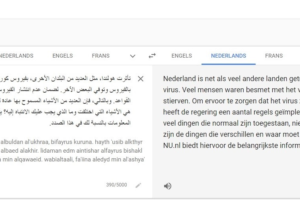Using Google Translate at University: A Match Made in Heaven or the Highway to Hell?
Oh, you know, I just Google Translated it. I’m sure most of you have heard someone say this recently. Maybe you even said it yourself. People say it like it’s the most obvious thing in the world to do. And the easiest, which is particularly telling in the Dutch expression Ik heb het even door Google Translate gehaald. “Even.” It’s true though – it’s easy and only takes a second.

Machine Translation, the process by which a computer or mobile phone application such as Google Translate, DeepL, Yandex or Papago automatically translates a text from one language into another without any human involvement, has become a part of everyday life. It is used not only by professional translators and language professionals, but in a wide range of contexts, both formal and informal.
And of course our students use it. But we don’t know when and why and how they use it. Do they understand how machine translation works, what it does and doesn’t do, when it can be used and when it shouldn't be? Do they know what the most common errors it makes are and when it is considered unethical to use it?
Leiden University is deeply concerned with data management and privacy, yet our staff and students use free, online machine translation apps all the time to translate all kinds of sensitive information. And Leiden University is committed to the idea that the increasing technologization and globalization of Dutch Higher Education cause a need for new transferable digital skills. But there is currently no formal instruction on how to use machine translation technology for educational and academic purposes, and most Course and Examination Regulations (Dutch: OER) do not specify when the use of such technology is allowed and when it isn’t. Is it allowed for homework and writing an e-mail to your instructor but fraud or plagiarism in an exam or thesis?

When, why and how students use machine translation
During the first phase of my NRO Comenius Senior Fellow project “The Value of Machine Translation in the Multilingual Academic Community” we launched a survey among students in Humanities at Leiden University to determine the current state of play. The results showed that students use machine translation every day, especially for educational purposes (rather than leisure or work), but they predominantly use it to look up single words, as an alternative to a dictionary. Many, if not most of them, did not seem to understand that machine translation is not a dictionary, and that it works better with context than isolated words. An overwhelming majority was familiar with Google Translate, but hardly any of the students were aware of other online translation websites such as DeepL or Bing/Microsoft. Many of the students also seemed sceptical about the value of machine translation at university – they assumed that its use is not permitted by lecturers for graded assignments or exams, especially in courses that intend to improve language skills. They seemed unaware of the many possibilities machine translation offers as a tool for knowledge assimilation and transfer, especially in providing access to research and resources published in other languages than English.
For those who want to know more about the findings of the survey, our first paper has just come out: Dorst, A.G., Valdez, S. & Bouman, H. (2022). Machine translation in the multilingual classroom: How, when and why do humanities students at a Dutch university use machine translation? Translation and Translanguaging in Multilingual Contexts, Online First Article. DOI: 10.1075/ttmc.00080.dor
Web-based toolkit for machine translation in higher education
During the second phase, we are now developing, implementing and evaluating a learning trajectory and online toolkit for machine translation in higher education. The toolkit will include explanatory web clips as well as practical activities and instruction guides. For example, we have developed activities to show students:
- how you can use machine translation to read academic papers in foreign languages and how you can then cite these foreign sources in your own paper or thesis;
- how to correct common errors in the output so you can use it as a basis for your own writing, but also how to write a text in such a way that it produces a better machine translation (e.g. how to avoid common errors in machine translation output);
- how to use machine translation output to study linguistic differences (personal pronouns in Japanese-English output are always a problem, as is gender in Finnish-English);
- how to study cultural differences, comparing for instance a Russian and American news text about the same event (How formal is the language? Are metaphors or puns used?);
or how to use machine translation to do fact checking or study data bias (just Google Translate “boerin” from Dutch to English and you’ll get the point).
And so we will soon be reaching out to you again to ask for volunteers willing to try out our materials! We hope the toolkit will show the many opportunities machine translation offers for educational purposes, and that it will empower students to use machine translation effectively and ethically. If we all become more critical, responsible and effective users of machine translation, then we can really use it to broaden our linguistic and cultural horizons and create a more diverse and inclusive academic community.


